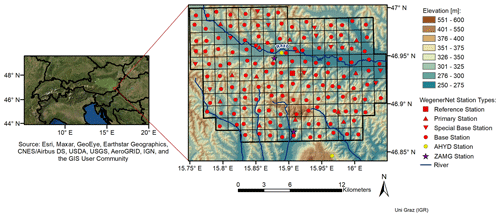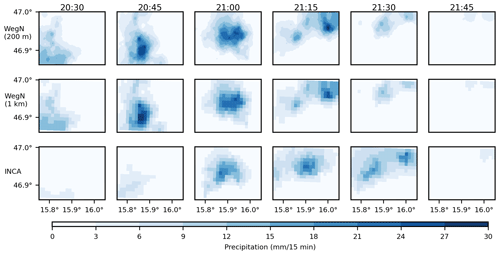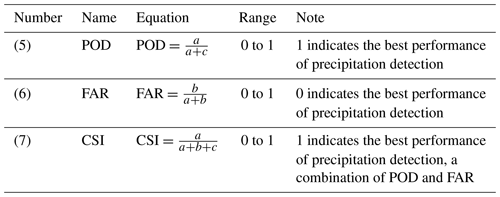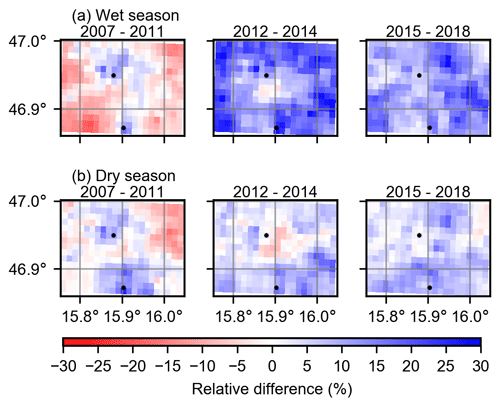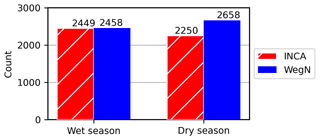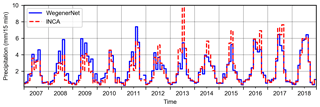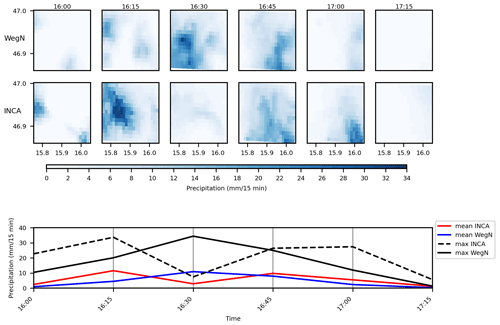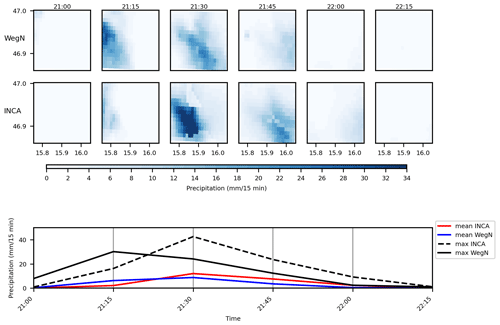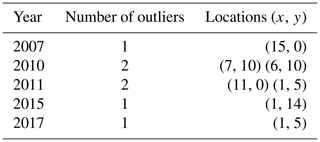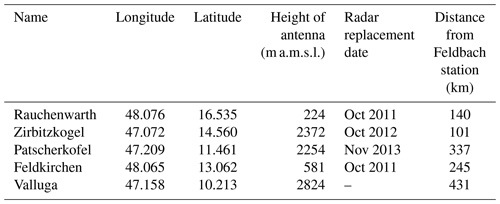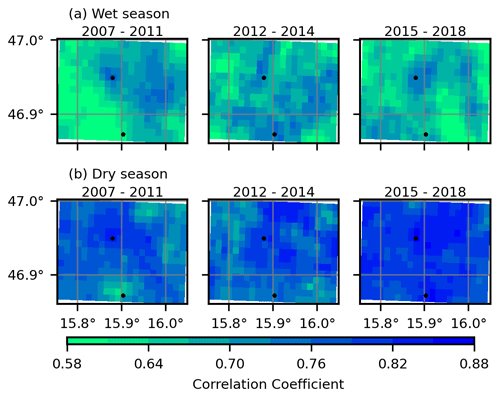the Creative Commons Attribution 4.0 License.
the Creative Commons Attribution 4.0 License.
Evaluation of Integrated Nowcasting through Comprehensive Analysis (INCA) precipitation analysis using a dense rain-gauge network in southeastern Austria
Esmail Ghaemi
Ulrich Foelsche
Alexander Kann
Jürgen Fuchsberger
An accurate estimate of precipitation is essential to improve the reliability of hydrological models and helps in decision making in agriculture and economy. Merged radar–rain-gauge products provide precipitation estimates at high spatial and temporal resolution. In this study, we assess the ability of the INCA (Integrated Nowcasting through Comprehensive Analysis) precipitation analysis product provided by ZAMG (the Austrian Central Institute for Meteorology and Geodynamics) in detecting and estimating precipitation for 12 years in southeastern Austria. The blended radar–rain-gauge INCA precipitation analyses are evaluated using WegenerNet – a very dense rain-gauge network with about one station per 2 km2 – as “true precipitation”. We analyze annual, seasonal, and extreme precipitation of the 1 km × 1 km INCA product and its development from 2007 to 2018. From 2007 to 2011, the annual area-mean precipitation in INCA was slightly higher than WegenerNet, except in 2009. However, INCA underestimates precipitation in grid cells farther away from the two ZAMG meteorological stations in the study area (which are used as input for INCA), especially from May to September (“wet season”). From 2012 to 2014, INCA's overestimation of the annual-mean precipitation amount is even higher, with an average of 25 %, but INCA performs better close to the two ZAMG stations. Since new radars were installed during this period, we conclude that this increase in the overestimation is due to new radars' systematic errors. From 2015 onwards, the overestimation is still dominant in most cells but less pronounced than during the second period, with an average of 12.5 %. Regarding precipitation detection, INCA performs better during the wet seasons. Generally, false events in INCA happen less frequently in the cells closer to the ZAMG stations than in other cells. The number of true events, however, is comparably low closer to the ZAMG stations. The difference between INCA and WegenerNet estimates is more noticeable for extremes. We separate individual events using a 1 h minimum inter-event time (MIT) and demonstrate that INCA underestimates the events' peak intensity until 2012 and overestimates this value after mid-2012 in most cases. In general, the precipitation rate and the number of grid cells with precipitation are higher in INCA. Considering four extreme convective short-duration events, there is a time shift in peak intensity detection. The relative differences in the peak intensity in these events can change from approximately −40 % to 40 %. The results show that the INCA analysis product has been improving; nevertheless, the errors and uncertainties of INCA to estimate short-duration convective rainfall events and the peak of extreme events should be considered for future studies. The results of this study can be used for further improvements of INCA products as well as for future hydrological studies in regions with moderately hilly topography and convective dominance in summer.
- Article
(3615 KB) - Full-text XML
- BibTeX
- EndNote
Precipitation is one of the most important components of the hydrological cycle and plays a crucial role in shaping the Earth's climate. It can trigger numerous natural hazards such as flash floods, soil erosion, and landslide, which often jeopardize human life and can cause tremendous economic loss (Lengfeld et al., 2020). More accurate precipitation estimates improve the reliability of hydrological models and numerical weather prediction models (NWPs) and can lead to a better understanding of uncertainties in climate model outputs. Furthermore, having a reliable estimate of precipitation is vital for decision making in hydrology, agriculture, and the economy (Ebert et al., 2007). Since the characteristics of a precipitation event can change rapidly in both time and space, accurate estimates with high spatial and temporal resolution remain challenging, especially in smaller-scale events (Villarini et al., 2008).
Rain gauges have been used as direct measuring devices to estimate precipitation for decades. Besides station-based data, remote sensing estimates, such as weather radar and satellite data, are meanwhile widely used. Each of these approaches has its strengths and weaknesses. For instance, rain gauges are more accurate in measuring intensity due to their direct measurement techniques. However, a spatially dense gauge network is required to detect small-scale convective events. Moreover, gauge data are subject to different types of errors, such as wind undercatch (Habib et al., 2001; Pollock et al., 2018; Schleiss et al., 2020). Furthermore, most rain gauges in mountainous areas are located in the valleys, which can lead to an underestimation of orographic rainfall in those areas (Ebert et al., 2007).
On the other hand, satellites can cover the entire globe, and weather radars have a high spatial resolution. They can estimate precipitation using various ranges of electromagnetic waves. Radar estimates are based on converting reflectivity of hydrometeors to rain rate (also known as the Z–R relationship), and different sources of errors and uncertainties can have considerable effects on these estimates. Beam over-shooting, partial beam filling, non-uniformity in the vertical profile of reflectivity (VPR), hardware calibration, a fixed Z–R relationship for different precipitation types, and random sampling errors are some examples of weather radar errors (AghaKouchak, 2010).
In general, considering these two approaches to be complementary and merging them can lead to more reliable estimates with a higher resolution (Goudenhoofdt and Delobbe, 2009). Using multiple sources of data, including radar, gauges, and model outputs, is beneficial to overcome some of the limitations addressed above (Ayat et al., 2021). However, the aforementioned errors and weaknesses in both rain gauges and radar estimates can still affect the reliability of the merged data and need to be considered (Haiden et al., 2011). The Integrated Nowcasting through Comprehensive Analysis (INCA) of the Austrian Central Institute for Meteorology and Geodynamics (ZAMG) provides high-resolution precipitation analyses and nowcasts by combining ground station, remote sensing, high-resolution topographic data, and NWP data. INCA's meteorological products are used, for example, as inputs for flood forecasting in the Alpine region and winter rail maintenance (Kann and Haiden, 2011).
The aim of this study is to evaluate INCA precipitation analyses over a period of 12 years, using gridded precipitation fields that are generated based on the dense WegenerNet weather and climate station network in southeastern Austria. The main focus lies on analyzing the ability of INCA to detect and estimate precipitation and on studying the impact of modifications of INCA algorithms and input data during these 12 years. We analyze annual data, seasonal data, and extremes using different metrics. Moreover, INCA's detection skill is studied using categorical metrics. Furthermore, we identify individual events using a simple threshold based on the interval between two consecutive events and compare the events' characteristics in both datasets. Finally, we separately study extreme convective short-duration events and demonstrate four representative examples. The following research questions are addressed and discussed in this study.
-
How well can INCA detect and estimate precipitation in an area with a moderate topography?
-
How did the developments in the Austrian radar network affect INCA's performance?
-
How reliable are INCA estimates of extremes?
This paper is structured as follows. In Sect. 2, we introduce the study area and each dataset's main features; in Sect. 3, the methodology is described. The results based on different timescales and individual events are discussed in Sect. 4, and we conclude in Sect. 5.
2.1 WegenerNet
The WegenerNet network is a dense climate station network located in the Feldbach region in southeastern Austria (see Fig. 1). The network includes 155 ground stations, almost uniformly spread over an area of about 22 km × 16 km (i.e., about 1 station per 2 km2) provided by the Wegener Center for Climate and Global Change, University of Graz, Austria (Kirchengast et al., 2014; Fuchsberger et al., 2021b). The highest altitude in this region is 609 m a.m.s.l. (above mean sea level), located in the southern part. The altitude decreases northward to the valley of the Raab River (see Fig. 1). The Feldbach region is affected by both Mediterranean and continental climates. Most of the precipitation occurs from May until September (here defined as the “wet season”), when monthly average precipitation is approximately twice as high as during the “dry season” from October to April (O and Foelsche, 2019). Considering that the average number of days with fresh snow in this area is less than 15 d during 1971 to 2000 (Prettenthaler et al., 2010) and has been decreasing over time, snowfall is relatively unimportant in this area.
Based on different instrumentations, WegenerNet includes five different station types (reference, primary, special base, base, and external stations). The base and special base stations in addition to an external station (141 stations in total) have unheated sensors to measure liquid precipitation. On the other hand, the primary and reference stations and another external station (14 stations in total) are equipped with heated sensors, and therefore they can measure snow and other forms of frozen precipitation too. We refer to Fuchsberger et al. (2021b) for more details on the different station types. WegenerNet has provided station time series and gridded datasets (based on the station data) of temperature, humidity, precipitation, and other parameters with 5 min temporal resolution since January 2007. The raw measurements are checked by seven layers of the quality control system (QCS), from checking station operation and availability to interstation consistency. For detailed descriptions of the quality control system, we refer to Kabas et al. (2011b), Kirchengast et al. (2014), Scheidl (2014), and Fuchsberger et al. (2021b). In this study, we used WegenerNet gridded data from WegenerNet's level-2 data (Fuchsberger et al., 2021a), generated with the inverse-distance-squared weighting method based on quality-controlled station data and provided on a 200 m grid. WegenerNet data have been validated against data from operational weather stations (O et al., 2018) and are shown to have a reliable performance in terms of magnitude, frequency, and the exact location of extreme events (O and Foelsche, 2019). The data have been used as a reference in multiple validation studies, a selection of which is addressed below.
Kann et al. (2015) used WegenerNet data to validate 6 months of INCA data (see Sect. 2.2), and O et al. (2017) used WegenerNet data as a reference to evaluate satellite data from the Global Precipitation Measurement (GPM) mission. Based on half-hourly Integrated Multi-satellitE Retrievals for GPM (IMERG) rainfall estimates for the period of April–October in 2014 and 2015, the results indicate that all IMERG products perform better in estimating moderate rainfall (0.3 to 3 mm per 30 min) than light and heavy rainfall events. In general, IMERG Early and IMERG Late overestimate low rain rates, and all three IMERG runs tend to underestimate heavy rain. In another study, Lasser et al. (2019) directly evaluated space-based GPM dual-frequency precipitation radar (DPR) estimates using WegenerNet gridded fields and showed that GPD DPR products tend to underestimate rainfall.
O and Foelsche (2019) analyzed the spatial variability of heavy rainfall events using WegenerNet gridded data. In addition, they described the dependency of area-mean rainfall on the number of gauges and temporal resolution during heavy events. The study showed that from May to September, the spatial variability in rainfall is higher than from October to April due to a higher proportion of convective events. Based on their results, the high density and the regular distribution of WegenerNet stations generate spatially homogeneous gridded rainfall fields. A complete up-to-date list of WegenerNet-related literature can be found at https://wegcenter.uni-graz.at/en/wegenernet/publications/ (last access: 30 June 2021).
2.2 INCA
The INCA precipitation analysis provides data on a 1 km × 1 km spatial grid with 15 min temporal resolution, using a combination of rain-gauge data, weather radar estimates, and high-resolution topography (Haiden et al., 2011). The following data are used as input for generating the INCA precipitation analysis product.
-
The topography, based on digital elevation data provided by the United States Geological Survey (USGS).
-
Precipitation data from about 250 semi-automatic ground stations (Teilautomatische Wetterstationen, TAWES), operated by the ZAMG, with an average interstation distance of 18 km, all of them located in Austria and two of them in the study area. Note that more stations have been added to the INCA analysis algorithm during the study period.
-
Precipitation data from the Austrian hydrographic service (AHYD), which were added over time.
-
Radar data from five Austrian C-band radars, supplemented by data from weather radars of neighboring countries. Starting from 2011, four of the Austrian radars were replaced by new ones (see Table B1 for more details).
INCA data are generated based on a Lambert conformal conic projection as a coordinate system, with reference latitudes 46 and 49∘ N and a central reference point at 47∘30′ N, 13∘20′ E. Steps taken to produce INCA precipitation analyses are described by Haiden et al. (2011). A brief summary of this process is given below.
-
Interpolation of station data using inverse-distance-squared weighting. Note that there are two ZAMG stations in the study area, namely, Feldbach station (11298) and Bad Gleichenberg (11244), which measure precipitation with 1 min temporal resolution. These two stations were added to this step in September 2011. Note that the average horizontal distance between ZAMG stations is approximately 18 km for the whole of Austria. The distance between Station 11298 and Station 1224, however, is approximately 10 km.
-
Climatological scaling of the radar data using a climatological scaling factor to partially correct topographic shielding. The scaling factor is the ratio between the multi-year, 3-monthly accumulated precipitation from the station data and the corresponding accumulated radar precipitation data.
-
Rescaling radar data using the latest observations: based on the comparison of observations and radar fields at the station locations, the fields from the last step are rescaled again. The rescaling is a weighted average of the ratio between the data from the radar and the nearest rain gauge, where the weight decreases with increasing distance, increasing difference in climatological scaling, and decreasing rain at the station.
-
Final combination: the precipitation fields from steps 1 and 3 are combined into INCA fields through a weighting relationship, where the weight factor decreases with increasing climatological scaling. At the station locations, INCA is equal to the interpolated station field of step 1. Between the stations, the weight of radar information increases. In the areas where the radar return is weak due to orographic shielding, the analysis reduces to station interpolation, considering elevation effects.
Related to this study, it should be noted that the closest radars to the study area are Zirbitzkogel (approx. 100 km) and Rauchenwarth (approx. 140 km) (see Table B1). Considering these distances and the mountains between the study area and radars, the minimum detection height by the radar network in the study area is about 2000 m above the ground, leading to detection and estimation errors. Based on Kann et al. (2015), the ground clutter correction is the only correction of radar data. Hence, some errors such as bright band, signal attenuation, scan strategy, radar miscalibration, radome wetting, and errors due to non-meteorological echoes may still exist in INCA precipitation products.
The WegenerNet and INCA datasets are generated differently regarding topography; i.e., WegenerNet is based on a simple inverse distance weighting (IDW) method, while INCA is generated considering the elevation effect. It should be noted that the INCA analysis dataset is produced for the whole of Austria. Since parts of Austria are covered by the Alps and their topography can significantly affect the precipitation estimates, these effects are considered in the INCA algorithm. However, the Feldbach region is located in a moderately hilly landscape, and the difference between the highest and lowest altitudes is approximately 300 m. So, we do not expect that topography can significantly affect the results in this area. Also, we did not find any systematic effect due to topography in our study (see Sect. 3.4). Haiden et al. (2011) presented INCA analysis and nowcasting products. In the study, they verified these products for the whole of Austria for a summer month and a winter month in 2009 and 2010, respectively. Kann and Haiden (2011) assessed the INCA analysis product for four events in 2008 in four different regions. Kann et al. (2015) used WegenerNet station data to evaluate 5 min INCA analysis data (rapid-INCA) for the wet season (April–September) of 2011 and four different heavy precipitation events. The study showed a general underestimation in rapid-INCA during the wet season. The rapid-INCA also underestimated the average precipitation rate in three out of four events. They also showed the roles of rain gauges and radars in rapid-INCA analysis performance.
However, the purpose of this study is to evaluate the INCA analysis product for 12 years (from 2007 to 2018) to show the changes in the INCA performance due to the installation of new radars and improving the INCA algorithm. Also, the performance of INCA to estimate precipitation extremes is shown using 12 years of data. In addition, an event-based approach is implemented to analyze all the individual events during these 12 years.
3.1 Data preparation
Precipitation data from 2007 to 2018 are used in this study. After transforming WegenerNet gridded data to the Lambert conformal conic projection, we used the conservative remapping scheme (Jones, 1999) to generate 1 km gridded fields (see Fig. B1). The conservative remapping scheme is based on preserving water flux and has been widely used as a remapping scheme for precipitation observations and climate model outputs (e.g., Chen and Knutson, 2008; O'Gorman, 2012; Nikulin et al., 2012; Sillmann et al., 2013; Prein and Gobiet, 2017; Tapiador et al., 2020; Fallah et al., 2020). We accumulated the 5 min WegenerNet data to 15 min to have the same temporal resolution in both datasets. As an example, Fig. 2 shows an intense precipitation event in May 2009 in INCA and WegenerNet gridded data with 15 min temporal resolution.
Although WegenerNet gridded data are generated from quality-controlled station data (Kirchengast et al., 2014), some errors may still remain in the data. The Mahalanobis distance method – an approach to find multivariate outliers (Ben-Gal, 2005) – was implemented to detect these possible errors in WegenerNet gridded data. A brief explanation of this approach can be found in Appendix A. We only found a few grid cells that had to be treated as outliers for parts of the measurement period (see Table A1): Station 44 is peculiar because it is located on top of a tall building, at 55 m above ground, and therefore suffers from stronger wind-induced undercatch. Station 145 is another outlier, which was detected by the WegenerNet team in 2015, which led to a replacement of its rain gauge. Since we found only a few outliers, it can be concluded that the operational quality control system of WegenerNet can filter outliers reasonably well.
3.2 Approaches
We use the annual area-mean precipitation and compare it in both datasets to gain a general overview of INCA developments and find possible systematic errors. The annual difference between the two datasets in each pixel is also calculated to portray the spatial pattern and the possible relation to ZAMG stations' distance. This is supported by a comparison of the INCA, ZAMG station, and WegenerNet data at the Feldbach station location (hereafter Feldbach cell). For WegenerNet values, we used the average of the four closest stations to the Feldbach cell (station numbers: 45, 46, 60, and 61), since there is no WegenerNet station located in this cell. As mentioned in Sect. 2.1, most of the precipitation occurs from May until September (hereafter wet season) due to a high proportion of convective events, and the other months (October to April) have noticeably less precipitation (hereafter dry season). To determine possible dependencies on the seasonality, we separately compare INCA and WegenerNet in the wet and dry seasons, respectively.
Since the Austrian weather radars overlook events that happen lower than about 2000 m above the ground in this region (due to radar beam blockage by the surrounding mountains) and the radar data are only corrected for ground clutter, some detection errors such as missing events and classifying non-precipitation phenomena as precipitation can occur. We implement three indices, probability of detection (POD), false alarm ratio (FAR), and critical success index (CSI) (Wilks, 2011), to address these errors in INCA. We calculate POD and FAR indices for each grid cell, classifying them into seven different precipitation intensities from 0.1 to 5 mm per 15 min. We then illustrate them for each pixel in order to analyze possible dependencies on the distance from the two ZAMG stations.
One way to address extreme precipitation is to consider the higher part of the intensity distribution (e.g., 99th quantile) as a threshold and calculate the average intensity of all time steps with higher intensities (the highest 1 %). The benefit of using this approach is that it includes changes in all events above the threshold (Haylock and Nicholls, 2000). We consider all events equal to or more than 0.1 mm per 15 min that happened in both datasets simultaneously and then calculate the average intensity of the highest 1 % for each dataset.
Since event-based analysis is important for some hydrological studies, such as soil erosion and runoff generation, we separate events in each dataset and evaluate INCA's ability from this perspective. We use a simple threshold based on the minimum dry period between two consecutive events (minimum inter-event time, MIT) to separate individual events. This approach has been used in different studies (e.g., Brown et al., 1985; Haile et al., 2011) to identify individual events. A wide range of MIT values has been selected in the literature. Choosing different MIT values leads to different characteristics of derived events. There should be a compromise between the independency of events and intra-event variability (Dunkerley, 2008). Since the study is affected by both convective and large-scale systems, we choose the MIT value to be 1 h and the minimum precipitation to be 0.1 mm per 15 min at any pixel. After separating events based on these criteria for each dataset, we analyze the characteristics of these events, such as event duration, accumulated precipitation, area-average intensity, peak intensity and average number of wet cells, in both INCA and WegenerNet. Note that the accumulated precipitation is the total amount of area-average precipitation during an event (mm), area-average intensity is the total precipitation divided by the duration of an event (mm h−1), peak intensity is the maximum intensity at a pixel during an event (mm per 15 min), and the average number of wet cells is the average number of cells that have more than 0.1 mm per 15 min of precipitation during an event.
To study extreme convective short-duration events (ECSDEs) based on the events in the previous paragraph, we define an ECSDE as having three characteristics: (1) the area-average intensity is more than the 95th quantile of WegenerNet intensities, (2) the duration is less than 4 h, and (3) a coverage of less than of the study area. We evaluate INCA's performance in these events with a focus on the spatial characteristics of four ECSDEs in both datasets along with the area-mean and peak intensities.
3.3 Comparison metrics
Error metrics have been widely used in many different disciplines, such as hydrology and hydrometeorology, to quantify model result accuracies or compare observations and forecasts. Each metric has its own strengths and weaknesses and quantifies a different aspect of the model performance. Hence, using multiple metrics for the comparison is more desirable (Jackson et al., 2019). We use four common metrics, bias, relative difference (RD), root mean square error (RMSE), and correlation coefficient (CC), for comparing INCA precipitation estimates with WegenerNet. These indices are computed according to Eqs. (1) to (4) in Table 1 below.
Table 1Comparison indices used in this study and their equations (partly adopted from Jackson et al., 2019).

RR and WR indicate the precipitation estimates by INCA and by WegenerNet, respectively; i is the index of the time step, N is the number of time steps and the top bar shows the average over time.
Additionally, in order to evaluate INCA's ability to detect precipitation, we analyzed three categorical indices, POD, FAR, and CSI, based on the equations in Table 2 below.
3.4 The effect of topography
To check the topography effect, we try two approaches. First, we check whether there is a meaningful relationship between altitude and precipitation using WegenerNet station data. The highest and lowest stations' altitudes are 257 and 520 m, respectively. The median is 327 m, and only two stations are located above 400 m (Fuchsberger et al., 2021b). Figure B2 shows the annual precipitation for each station and its corresponding altitude. Note that the annual precipitation is calculated using the average of annual data from 2007 to 2018 for each station. As can be seen, there is no noticeable trend regarding the effect of topography. It is worth mentioning that the stations with annual precipitation lower than 750 mm yr−1 are stations 44, 151, and 145. As discussed in Sect. 3.1, these stations tend to systematically underestimate precipitation.
In another approach we choose a non-convective event in both INCA and WegenerNet datasets and check whether there is a relationship between altitude and the difference between these two datasets. Based on the individual events (Sect. 3.2), we select an event where more than 300 cells are wet cells (on average) and the duration of the event is more than 4 h. Based on these criteria, we select an event on 11 October 2015. Then, we choose the highest altitude point (x=11, y=4) and the lowest point in the Raab Valley (x=21, y=9) in the gridded data. After that, we calculate the difference between INCA and WegenerNet for both of these points. In addition, we consider the spatial average of differences between INCA and WegenerNet. Similarly to the first approach, no trend was found due to the topography of the study area, which can affect our analysis (not shown).
4.1 Annual precipitation
The area mean of annual precipitation in INCA and WegenerNet datasets and the average of WegenerNet stations are shown in Fig. 3a. The annual average of precipitation in the 12 years from 2007 to 2018 is 979 mm in INCA and 881 mm in WegenerNet. Overall, INCA area-mean values exceed WegenerNet values, with an average relative difference of 11 %. The only year that INCA underestimates precipitation is 2009, a year with particularly high precipitation: at the long-term ZAMG station Bad Gleichenberg, it was the wettest year since 1937. From 2012 to 2014, the overestimation by INCA is even larger, with an average relative difference of 24.5 %. It is worth noting here that the difference between the average precipitation of WegenerNet stations and the area-mean gridded data is negligible (0.15 % on average).
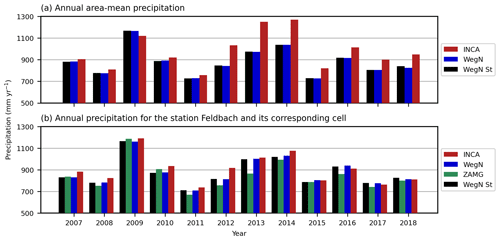
Figure 3(a) Annual area-mean precipitation. (b) Annual precipitation for ZAMG Station 11298 (Feldbach) and its corresponding cell.
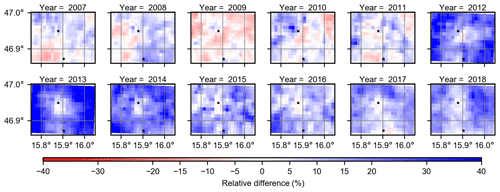
Figure 4Annual relative difference between INCA and WegenerNet in each pixel. The black dots indicate the two ZAMG stations in the study area.
Annual precipitation in the Feldbach cell is shown in Fig. 3b. Similarly to the annual area-mean value, INCA also overestimates precipitation in this cell but to a smaller amount, with an average relative difference of 3 %. In this cell, from 2007 until 2014, INCA overestimated precipitation with an average of about 5 % and a maximum of 13 % in 2012. Starting from 2015, INCA tends to underestimate precipitation by an average of 1.3 % and a maximum of 2.8 % in 2016. Compared to the annual-mean values, INCA performs better in this cell, indicating the importance of the rescaling step (step 3 in Sect. 2.2) in the INCA estimates. Also, INCA values are consistently higher than those of the ZAMG station Feldbach, with an average of 7 %. As shown in Fig. 3b, INCA has considerably higher values than the Feldbach station in 2012 and 2013, with a relative difference of 21 % and 17 %, respectively. It is worth mentioning that the Feldbach station has lower values than WegenerNet except for 2007, 2009, and 2010. Based on these results, we can conclude that using the merged radar-gauge data leads to more accurate estimates than individual ZAMG station data, even at the ZAMG station location. Furthermore, and similarly to Fig. 3b, we show the annual precipitation in the cell where station Bad Gleichenberg is located (Fig. B3). Compared to station Feldbach, the difference between INCA and WegenerNet is higher, which could be due to the weight of this station in step 1 (see Sect. 2.2).
Figure 4 shows annual maps of the relative differences between INCA and WegenerNet. Similarly to Fig. 3, there is a considerable overestimation in INCA from 2012 to 2014, especially in the cells that are far from ZAMG stations. Since there was a replacement period of the Austrian radars (starting in October 2011, details in Table B1) and since the closest radar (Zirbitzkogel) was off during two periods of time (June 2012–October 2012 and February 2013–March 2013), we interpret this overestimation as an error of the radar data. This error was partly removed close to the ZAMG stations by step 4 of the INCA data preparation (see Sect. 2.2).
As shown in Fig. 4, the INCA performance can be divided into three different periods: 2007–2011, 2012–2014, and 2015–2018. From 2007 to 2011, INCA generally overestimated precipitation, except for 2009. In general, the annual area-mean differences differ between −3.9 % and +4.3 %, with an average of 1.9 % in this period. In addition, there was no specific pattern close to the two ZAMG stations since these stations were added to the INCA algorithm in September 2011. Although the relative differences of area-mean values are positive in this period except 2009, INCA underestimates precipitation in some cells.
From 2012 to 2014, INCA considerably overestimated precipitation in almost all grid cells, and the annual area-mean difference rose to almost 29 % in 2013. As shown, relative differences are lower at the cells closer to ZAMG stations, especially around the Feldbach station. We interpret this increase in overestimation as an error, introduced by the new radar, which was partly removed by the calibration with ZAMG station data.
From 2015 to the end of 2018, the overestimation by INCA was still predominant. The overestimation, however, is smaller compared to the previous period. Nevertheless, annual-mean differences are almost always positive, with typical values between +11 % and +15 % and an average of +12.5 %. This overestimation is smaller in the grid cells near the two ZAMG stations, indicating again the role of these stations in adjusting radar data in the INCA algorithm.
Note that we also calculate RMSE for the annual precipitation (see Fig. B4). There is no noticeable spatial pattern in the first period, and the minimum and maximum of area-mean annual RMSE are 45.0 and 57.5 mm, respectively. This error is considerably higher in the second period, with a minimum and maximum of 191.0 and 278.0 mm, respectively. In this period, RMSE is lower close to the Feldbach station (just like the relative difference in Fig. 4). Similarly to the relative difference, the area-mean annual RMSE decreases in the 2015–2018 period. For this period, the minimum RMSE is 92.6 mm in 2015 and the maximum RMSE is 124.1 mm in 2018.
As mentioned before, more stations were added to the INCA algorithm during the years. To study possible changes in INCA estimates after adding these stations, the raw radar data used in INCA should be included in future analyses.
4.2 Precipitation detection
Figure 5 shows POD and FAR values for different thresholds for each cell for the three different time periods identified above. The dashed black and solid black lines indicate POD and FAR for the Feldbach cell. As can be seen, INCA's ability to detect precipitation decreases at higher intensities. The change in POD and FAR in the Feldbach cell is different. At thresholds lower than 0.5 mm per 15 min, it has lower POD than other cells, especially since 2012. The FAR value performs better compared to other cells at lower thresholds. This could be due to the INCA algorithm for removing false precipitation events, which unintentionally removes some light precipitation events.

Figure 5POD and FAR values based on different thresholds for each cell for 2007–2011 (a), 2012–2014 (b), and 2015–2018 (c). Note that the dashed black and black lines indicate POD and FAR for the Feldbach cell, respectively.
Generally, INCA has the highest POD values at a threshold of 0.1 mm per 15 min. With increasing precipitation intensity, POD tends to decrease. The FAR values also have the best performance at 0.1 mm per 15 min and start to increase with higher intensities. When longer time intervals (e.g., 1, 3, and 6 h) are considered, the detection errors decrease (not shown).
Figure 6 shows POD and FAR for each grid cell based on the 0.1 mm per 15 min threshold for the three periods, separated into wet and dry seasons. The FAR performs better in the grid cells near the two ZAMG stations. POD, however, has lower values in those cells. As previously mentioned, this may be due to the INCA algorithm, which unintentionally removes some light events. The ability of INCA in detecting precipitation is noticeably higher in wet seasons.

Figure 6POD and FAR for 15 min data based on the 0.1 mm threshold for three different periods of time for wet (a) and dry (b) seasons. The black dots indicate the two ZAMG stations.
We also calculated CSI for each cell (Fig. B5). Since CSI is a combination of POD and FAR, its behavior is a combination of POD and FAR; i.e., CSI performs better during the wet season. CSI values are higher in the third period (2015–2018) for the dry seasons. Since the weight of the radar estimate becomes higher with increasing distance from the ZAMG stations in the INCA algorithm (see Sect. 2.2), we conclude that the radar detected some precipitation events, which were not observed by ground stations. Since the radar sees precipitation in the study area only beyond about 2000 m above the ground and some errors are not corrected (see Sect. 2.2), “false events” can be due to events that do not reach the ground due to evaporation or due to non-precipitating phenomena. The latter error can explain higher FAR values in the cells with longer distances from ZAMG stations.
4.3 Seasonal comparison
Figure 7 displays the mean relative differences between INCA and WegenerNet in the wet (May–September) and dry (October–April) seasons for the three periods. In contrast to the relative differences in Fig. 4, these differences were calculated for events with precipitation of equal to or more than 0.1 mm per 15 min that happened in both datasets. The 0.1 mm threshold is implemented due to the resolution of the tipping bucket gauges used in WegenerNet. In the first period, both overestimation and underestimation can be detected in INCA grid cells. Starting in 2012, overestimation is dominant in most INCA grid cells, similarly to annual precipitation. This overestimation is higher in the wet seasons and grid cells farther away from the two ZAMG stations. We can conclude that the new radar settings (cf. Sect. 2.2) tend to overestimate precipitation and that the INCA algorithm works reasonably well closer to the two ZAMG stations. However, the overestimation farther away from those stations is still considerably large. The higher relative difference in wet seasons is an indication of difficulties in the radar network to estimate intense rainfall events. Considering RMSE, the pattern is similar to the relative difference (not shown).
Furthermore, we calculate the temporal correlation coefficient between INCA and WegenerNet (Fig. B6). Based on these results, the correlation is noticeably lower in the wet seasons. We interpret this as a consequence of a higher percentage of convective events, which are harder to capture. Similarly to the relative difference, INCA performs better in the cells close to the ZAMG stations in the wet seasons.
4.4 Extreme precipitation
In this section, we compare extreme events in INCA and WegenerNet based on the different seasons for the three periods. Note that the 99th quantile was calculated for time steps with precipitation equal to or more than 0.1 mm per 15 min, which happened in both datasets (see Sect. 3.2). Figure 8 shows the mean values of all time steps exceeding the 99th quantile in each pixel for both datasets and the relative differences in wet and dry seasons.
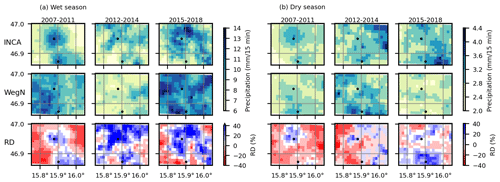
Figure 8Spatial patterns and relative difference of the mean of all time steps exceeding the 99th quantile for INCA and WegenerNet for (a) wet and (b) dry seasons in the first (left), second (middle), and third (right) periods.
From 2007 to 2011, INCA tends to overestimate extreme precipitation in cells close to the two ZAMG stations and underestimated it in the other parts of the study area, similarly to the mean seasonal values (see Fig. 7). Compared to the mean seasonal values, underestimation is larger in extreme precipitation, especially in the dry season. The maximum and minimum differences in this period are 26 % and −45 %, respectively. It is worth mentioning that the spatio-temporal evolution of extremes is not particularly well captured by INCA (cf. Fig. 2).
Between 2012 and 2014, an overestimation of INCA in the corresponding cells of ZAMG stations is also noticeable, particularly in the wet season. In contrast to annual and mean-seasonal values, there is no relationship between distance from ZAMG stations and the relative difference. In the dry season, INCA shows less underestimation than in the first period. The maximum and minimum differences in this period are 101 % and −36 %, respectively. For wet seasons in the 2015–2018 period, the behavior was relatively similar to the second period, with a decrease in overestimation. In this period, the maximum and minimum differences are 44 % and −29 %, respectively. Based on these results, the overestimation of INCA is larger in extremes, especially in the wet seasons.
4.5 Event-based evaluation
In this section, we consider individual events, and based on the criteria we described in Sect. 3.2, we identified 4699 separate events in INCA and 5116 in WegenerNet over 12 years. The number of events in different seasons is shown in Fig. 9. Similarly to Sect. 4.2, the number of detected events in INCA is lower in the dry seasons. Note that the number of dry-season events can be slightly biased in WegenerNet, due to snowfall events, which can get recorded twice: once when the snow is measured by heated rain gauges and again when the snow melts at the unheated gauges. In general, snowfall events in the region are rare (cf. Sect. 2.1); thus, we do not expect them to have significant influence in metrics other than the number of events. Another effect on the number of dry season events is that the radars tend to miss precipitation more often in winter due to beam blockage by surrounding mountains (cf. Sect. 2.2), especially for low-lying clouds, which are often present in the dry season.
Table 3 describes the statistics of separate events in both INCA and WegenerNet. Note that the accumulated precipitation and precipitation rate are based on the area-mean value in each time step. The peak intensity, however, is the maximum value that happened in one cell during an event.
Table 3Descriptive statistics for separate events in INCA and WegenerNet based on the 1 h interval (based on definitions in Sect. 3.2).

Based on Table 3, the average accumulated precipitation and the precipitation rate measured by INCA are higher than WegenerNet. Similarly, the average number of wet cells is higher in INCA, which can affect the accumulated precipitation. The difference between the average number of wet cells in INCA and WegenerNet is higher in the dry season. This could be due to a slightly lower effective resolution of INCA in the study area, where the radar beam of the nearest radar is already comparatively wide. While the average duration of events only differs by 3 min, the difference increases significantly for longer events.
To check a possible time shift in INCA, we consider events that fulfill the following conditions: (1) the absolute difference between the starting time of an event in INCA and WegenerNet is less than 1 h and (2) the absolute difference between the ending time of an event in INCA and WegenerNet is less than 1 h. Based on these criteria, INCA started earlier to detect precipitation in 34 % of these events with an average of 25 min. Both datasets started at the same time for 35 % of the events, and for the rest (31 %), INCA started later by an average of 23 min. For the ending of an event, 54 % of events end later in INCA by an average of 24 min, and 20 % end earlier by an average of 26 min. Note that starting/ending time is considered within 15 min since the temporal resolution is 15 min.
To separate the errors associated with time shift from errors related to intensity, we focus only on those events that happened at the same time in both datasets, and we found 2949 events. Similar to the results in Table 3, the accumulated precipitation is higher in INCA, and the bias value is 0.14 mm 15 min−1. Although INCA overestimates accumulated precipitation most of the time, the peak intensity is slightly higher in WegenerNet except during July. The overall bias for peak intensity is −0.04 mm 15 min−1.
We also studied the time of the peak intensity in both datasets and found that the peak happens during the first half of the event duration. Also, in the majority of events, the peak intensity in INCA happens slightly later (approximately 5 min) than in WegenerNet.
The monthly average of the peak intensity is shown in Fig. 10. INCA generally underestimates the precipitation peaks in the first period but generally overestimates them from mid-2012 onwards. This behavior is likely due to the change in the radar network in 2012. There is a noticeable peak-intensity overestimation in mid-2013. In contrast to the mean precipitation (see Figs. 3a and 4), the differences in peak intensity between INCA and WegenerNet decreased significantly in 2018.
4.5.1 Extreme convective short-duration events
Based on these events and the criteria described in Sect. 3, there are 62 ECSDEs detected by WegenerNet during the 12-year study period. Among these 62 events, 47 are detected by INCA. The same underestimation pattern before 2012 and overestimation afterward (see Fig. 10) can be seen in accumulated precipitation and peak intensity. The highest underestimation of accumulated precipitation happened in 2009 (up to 40 %). For the peak intensity, INCA underestimates it by up to 60 % in 2008 and overestimates it by approximately 65 % in 2015. The results are similar to the extremes in Sect. 4.4.
To check the ECSDE's spatial patterns in both datasets, we focus on four examples of these events. As shown in Fig. 3a and discussed in Sect. 4.1, the precipitation amount was considerably higher in 2009. We choose the first ECSDE from this year, which has the highest peak intensity in 2009. The second event in 2011 is special because INCA overestimated accumulated precipitation but underestimated the peak intensity. The third and fourth events are selected from the third period (2015–2018) with different characteristics to show INCA's performance based on the latest improvements. The third event has the highest maximum intensity in INCA, and the fourth event's peak intensity is highest in this period (2015–2018).
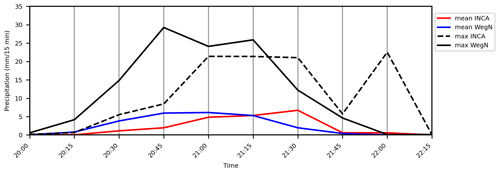
Figure 11Time series of area-mean and maximum values in INCA and WegenerNet for the event on 18 May 2009.
Event on 18 May 2009
In Fig. 2, we already showed the difference in the spatial structure of this extreme event on 18 May 2009, in both INCA and WegenerNet. Based on WegenerNet data, the accumulated rainfall over the entire study area was 23.7 mm in 2 h, but the accumulated rainfall that happened in the wettest cell was 46.6 mm. As shown in Fig. 11, WegenerNet detected two peaks for this event at 20:45 and 21:15 CET (central European time). In INCA, however, the two peaks happened at 21:00 and 22:00 CET. It is worth mentioning that the location of the peak(s) is also different in INCA (see Fig. 2). The area mean of rainfall shows a time shift in INCA of 30 min. In addition, rainfall starts and ends earlier in INCA, and INCA has more wet cells during this event.
Event on 1 September 2011
During this event, an areal average of 27.6 mm fell in 3.25 h (50 mm in the wettest cell). There is a time shift in the peak intensity and area-average rainfall. In contrast to the event in 2009, the peak intensity happened one time step earlier in INCA. The differences between INCA and WegenerNet values are smaller than in the previous event. As can be seen in Fig. 12, INCA starts to detect earlier and finishes later than WegenerNet, and INCA has more wet cells. Comparing these results with those by Kann et al. (2015), we see that the 15 min INCA precipitation analysis performs better than 5 min rapid-INCA. The time shift in detection was also observed in rapid-INCA, caused by radar data.
Event on 16 August 2016
Based on WegenerNet data, the areal average of the total amount of rainfall was 19.4 mm, which fell in 2.25 h (36.5 mm in the wettest cell). INCA overestimated the event peak by about 40 % in this event. Similarly to the event in 2009, there is a time lag in INCA's detection of the rainfall peak (Fig. 13). The highest value of the area-mean rainfall happened at 21:30 CET in both datasets. This event starts earlier and finishes later in INCA, with more wet cells in WegenerNet.
Event on 15 July 2018
The areal average of accumulated rain was just 10.8 mm that fell in 2.5 h. However, the accumulated rain in the wettest cell was 59.6 mm in this event. INCA detected the peak intensity one time step later and had lower values than WegenerNet. The maximum value of rainfall in this event happened at 14:00 CET in WegenerNet, and INCA significantly underestimates this value (Fig. 14). It is worth mentioning that the location of the maximum value is far from the two ZAMG stations. This event starts and ends earlier in INCA with a higher number of wet cells.
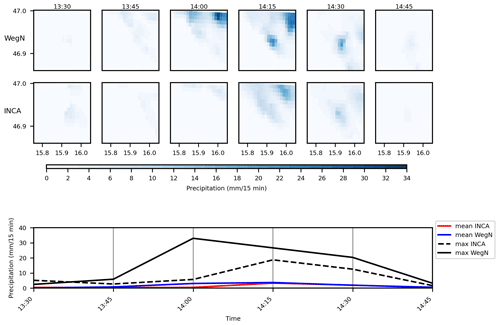
Figure 14An event on 15 July 2018 in WegenerNet (top) and INCA (center) and time series of maximum and areal mean values in INCA and WegenerNet (bottom).
INCA detects the peak intensity later than WegenerNet, except for the event on 1 September 2011. INCA underestimates the peak intensity in two events (2009 and 2018) and overestimates this value in the 2016 event. The overestimation and underestimation are more pronounced for peak intensities than for area-mean values. These error and time shifts in detection may affect the performance of flood warning systems.
Compared to the rapid-INCA product (Kann et al., 2015), the INCA analysis product performs similarly in 2011, i.e., underestimates precipitation in most cells in the wet season. The IMERG products (O et al., 2017) underestimate heavy precipitation during 2014–2015 in the study area. One should note that this comparison may not be entirely reliable since the temporal and spatial resolutions of IMERG products are coarser than INCA analysis products. In general, the INCA analysis product can be used for different hydrological purposes, considering it is a real-time operational product with high temporal and spatial resolution. Also, the results show that improvements in the INCA analysis product are taking place. It should be noted that INCA precipitation products have a high spatial and temporal resolution, and some errors such as wind drift become more pronounced in higher resolutions. Also, the height that radars can detect precipitation increases with the range from the radar site, which can significantly impact the accuracy of the radar estimates (Harrison et al., 2009). Since the closest radar sees precipitation only above 2000 m from the ground, this can be the main source of uncertainty in detection and estimation of precipitation in the INCA analysis products over the study area. Additionally, there are some sources of uncertainties in the WegenerNet products, such as unheated sensors, wind effects, and the interpolation of data that may have negative effects on the quality of the WegenerNet gridded dataset.
The evaluation of precipitation estimates helps to improve the understanding of errors and uncertainties from different sources (e.g., systematic errors, random errors, and spatio-temporal dependency). In this study, we evaluated INCA (Integrated Nowcasting through Comprehensive Analysis) precipitation analysis products of the ZAMG (the Austrian Central Institute for Meteorology and Geodynamics), using WegenerNet high-resolution gridded data from 2007 to 2018 in southeastern Austria. First, we compared annual precipitation estimates of INCA and WegenerNet for each pixel and the area-mean values. In general, INCA overestimates the area-mean annual precipitation except in 2009, which was a particularly wet year. The performance of INCA can be divided into three different periods: from 2007 to 2011, both overestimation and underestimation are observed in INCA, with more pronounced underestimation in the wet season. Starting in 2012, INCA considerably overestimates precipitation by up to 60 %. However, this overestimation is less pronounced close to the Feldbach station. Since the weight of the gauge estimation decreases with increasing distance from the gauge, we concluded that this increase in the overestimation is a result of systematic errors from newly installed radars and can be partly removed closer to the gauges. Starting in 2015, this spatial pattern continues but with a lower overestimation compared to the second period.
We used categorical metrics to study the ability of INCA in detecting precipitation. Generally, the number of false events is smaller in the cells closer to ground stations operated by the ZAMG (which are used as input for INCA), especially in the wet season. Surprisingly, the number of true events close to the ZAMG stations is comparably smaller too. This could be because the INCA algorithm removes false precipitation events and unintentionally removes some light precipitation events. We evaluated extremes during these three periods and for wet and dry seasons. In the first period, INCA overestimates precipitation in cells close to the ZAMG stations and underestimates it in other cells, especially during the wet season. This overestimation is more noticeable and dominates most of the study area in the wet season from 2012 until 2014. However, for the dry seasons in this period, underestimation by INCA is dominant. For the third period, the pattern for the wet seasons is similar, but INCA tends to overestimate extremes during the dry seasons.
We also considered individual events in both datasets and analyzed their characteristics. Based on these results, INCA tends to underestimate the peak precipitation intensity of the events until mid-2012 and overestimates it afterward. The largest overestimation of the peak intensity happened in July. Generally, the precipitation rate is higher in INCA, and there is a time shift for event detection in INCA. Based on our results, INCA starts to detect precipitation earlier than WegenerNet in 34 % of the events and ends up detecting it later than WegenerNet in 54 % of the events. Considering four examples of extreme short-duration convective events, there is a time shift in detecting the peak intensity in INCA. In these events, the peak intensity bias is considerably larger than in all events. INCA has been improving in detecting and estimating precipitation, and the errors of the new radars have been decreasing since 2015. However, there are errors due to radar estimates (e.g., radar detection height) and the algorithm for merging radar and rain gauges, which can negatively affect the INCA analysis product. In addition, it is shown that gauges are crucial for correcting some errors due to radar estimates. To study the impact of extreme short-duration events, careful consideration must be taken when using merged rain-gauge–radar products. Generally, we expect that these results will be representative of other areas with the similar topography and climatology (moderately hilly terrain and convective dominance in summer).
Suggestions for future studies
For future studies, it is suggested to include the raw radar data used in INCA in the analysis to separate errors due to radar estimates. Also, we suggest using the results of this study to consider high-impact events and analyze the effects of INCA uncertainties on risk management. In addition, the relation between wind speed and precipitation estimates in both gauges and radars needs to be considered separately.
The Mahalanobis distance in matrix notation is calculated by the formula below:
where x is a data vector, m is the multivariate mean, and C is the estimated data covariance matrix (Filzmoser, 2016). After calculating Mahalanobis distance for each year, we compute the 99th quantile of the chi-square distribution with 2∘ of freedom. Based on this, cells that have Mahalanobis distances above 13.8 are considered outliers. The numbers and locations of these outliers are shown in Table A1.
The cell with the coordinates (x=7, y=10) underestimated rainfall and was considered an outlier in 2010. This cell is the corresponding cell of station 44, which is located on the top of a tall building. Furthermore, the cell with the coordinates (x=11, y=0) underestimated rainfall and was considered an outlier in 2011. This cell refers to Station 145. Starting from 2015, the Mahalanobis values for this cell were below the threshold, which is the year when the station has been replaced.
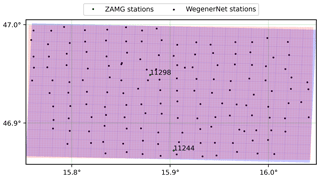
Figure B1Locations of WegenerNet stations (black circles) and ZAMG stations (green circles), WegenerNet original (red cells), and after the transforming–regridding process (blue cells).
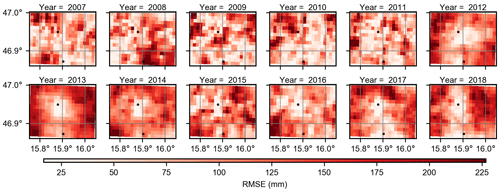
Figure B4Annual RMSE in each pixel. The black circles indicate the two ZAMG stations in the study area.
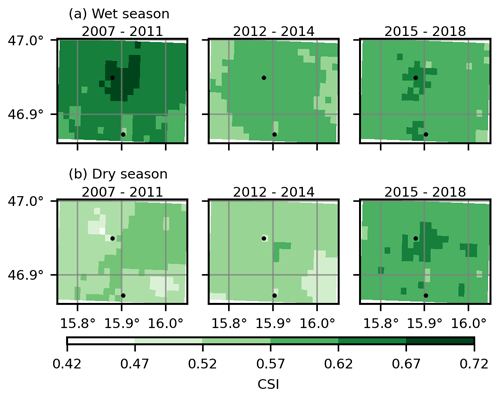
Figure B5The CSI values for 2007–2011 (left), 2012–2014 (center), and 2015–2018 (right) in wet (a) and dry (b) seasons. Note that only events equal to or more than 0.1 mm per 15 min were considered. The black circles indicate the two ZAMG stations in the study area.
WegenerNet data products are available at https://doi.org/10.25364/WEGC/WPS7.1:2021.1 (Fuchsberger et al., 2021a). INCA data were provided by the Central Institute for Meteorology and Geodynamics (ZAMG) and are not publicly available.
EGH and UF set up and designed the study. JF provided in-depth knowledge about WegenerNet data, AK about INCA data. EGH performed the computational and analytical work and prepared the paper, with contributions by UF, JF, and AK. All the authors contributed to the interpretation of the results.
The authors declare that they have no conflict of interest.
Publisher's note: Copernicus Publications remains neutral with regard to jurisdictional claims in published maps and institutional affiliations.
The authors thank Gottfried Kirchengast and Raoul Collenteur (University of Graz) for fruitful discussions. Furthermore, we would like to thank the Austrian Central Institution for Meteorology and Geodynamics (ZAMG) for the kind provision of INCA data. WegenerNet funding is provided by the Austrian Ministry for Science and Research, the University of Graz, the state of Styria (which also included European Union regional development funds), and the city of Graz; detailed information can be found online (http://www.wegcenter.at/wegenernet, last access: 16 January 2021).
This work is funded by the Austrian Science Fund (FWF) under research grant W1256 (doctoral program Climate Change – Uncertainties, Thresholds and Coping Strategies).
This paper was edited by Jim Freer and reviewed by two anonymous referees.
AghaKouchak, A.: Simulation of remotely sensed rainfall fields using copulas, PhD thesis, Inst. f. Wasserbau, Stuttgart, 2010.
Ayat, H., Evans, J. P., Sherwood, S., and Behrangi, A.: Are Storm Characteristics the Same When Viewed Using Merged Surface Radars or a Merged Satellite Product?, J. Hydrometeorol., 22, 43–62, https://doi.org/10.1175/JHM-D-20-0187.1, 2021.
Ben-Gal, I.: Outlier Detection, in: Data Mining and Knowledge Discovery Handbook, edited by: Maimon, O. and Rokach, L., Springer US, Boston, MA, 131–146, https://doi.org/10.1007/0-387-25465-X_7, 2005.
Brown, B. G., Katz, R. W., and Murphy, A. H.: Exploratory Analysis of Precipitation Events with Implications for Stochastic Modeling, J. Clim. Appl. Meteorol., 24, 57–67, https://doi.org/10.1175/1520-0450(1985)024<0057:EAOPEW>2.0.CO;2, 1985.
Chen, C.-T. and Knutson, T.: On the Verification and Comparison of Extreme Rainfall Indices from Climate Models, J. Climate, 21, 1605–1621, https://doi.org/10.1175/2007JCLI1494.1, 2008.
Dunkerley, D.: Identifying individual rain events from pluviograph records: a review with analysis of data from an Australian dryland site, Hydrol. Process., 22, 5024–5036, https://doi.org/10.1002/hyp.7122, 2008.
Ebert, E. E., Janowiak, J. E., and Kidd, C.: Comparison of Near-Real-Time Precipitation Estimates from Satellite Observations and Numerical Models, B. Am. Meteorol. Soc., 88, 47–64, https://doi.org/10.1175/BAMS-88-1-47, 2007.
Fallah, A., Rakhshandehroo, G. R., Berg, P., O, S., and Orth, R.: Evaluation of precipitation datasets against local observations in southwestern Iran, Int. J. Climatol., 40, 4102–4116, https://doi.org/10.1002/joc.6445, 2020.
Filzmoser, P.: Identification of Multivariate Outliers: A Performance Study, Aust. J. Stat., 34, 127–138, https://doi.org/10.17713/ajs.v34i2.406, 2016.
Fuchsberger J., Kirchengast, G., Bichler, C., Leuprecht, A., and Kabas, T.: WegenerNet climate station network Level 2 data version 7.1 (2007–2020), University of Graz, Wegener Center for Climate and Global Change, Graz, Austria, [data set], https://doi.org/10.25364/WEGC/WPS7.1:2021.1, 2021a.
Fuchsberger, J., Kirchengast, G., and Kabas, T.: WegenerNet high-resolution weather and climate data from 2007 to 2020, Earth Syst. Sci. Data, 13, 1307–1334, https://doi.org/10.5194/essd-13-1307-2021, 2021b.
Goudenhoofdt, E. and Delobbe, L.: Evaluation of radar-gauge merging methods for quantitative precipitation estimates, Hydrol. Earth Syst. Sci., 13, 195–203, https://doi.org/10.5194/hess-13-195-2009, 2009.
Habib, E., Krajewski, W. F., and Kruger, A.: Sampling Errors of Tipping-Bucket Rain Gauge Measurements, J. Hydrol. Eng., 6, 159–166, https://doi.org/10.1061/(ASCE)1084-0699(2001)6:2(159), 2001.
Haiden, T., Kann, A., Wittmann, C., Pistotnik, G., Bica, B., and Gruber, C.: The Integrated Nowcasting through Comprehensive Analysis (INCA) System and Its Validation over the Eastern Alpine Region, Weather Forecast., 26, 166–183, https://doi.org/10.1175/2010WAF2222451.1, 2011.
Haile, A. T., Rientjes, T. H. M., Habib, E., Jetten, V., and Gebremichael, M.: Rain event properties at the source of the Blue Nile River, Hydrol. Earth Syst. Sci., 15, 1023–1034, https://doi.org/10.5194/hess-15-1023-2011, 2011.
Harrison, D. L., Scovell, R. W., and Kitchen, M.: High-resolution precipitation estimates for hydrological uses, Proc. Inst. Civ. Eng. – Water Manage., 162, 125–135, https://doi.org/10.1680/wama.2009.162.2.125, 2009.
Haylock, M. and Nicholls, N.: Trends in extreme rainfall indices for an updated high quality data set for Australia, 1910–1998, Int. J. Climatol., 20, 1533–1541, https://doi.org/10.1002/1097-0088(20001115)20:13<1533::AID-JOC586>3.0.CO;2-J, 2000.
Jackson, E. K., Roberts, W., Nelsen, B., Williams, G. P., Nelson, E. J., and Ames, D. P.: Introductory overview: Error metrics for hydrologic modelling – A review of common practices and an open source library to facilitate use and adoption, Environ. Model. Softw., 119, 32–48, https://doi.org/10.1016/j.envsoft.2019.05.001, 2019.
Jones, P. W.: First- and Second-Order Conservative Remapping Schemes for Grids in Spherical Coordinates, Mon. Weather Rev., 127, 2204–2210, https://doi.org/10.1175/1520-0493(1999)127<2204:FASOCR>2.0.CO;2, 1999.
Kabas, T., Foelsche, U., and Kirchengast, G.: Seasonal and Annual Trends of Temperature and Precipitation within 1951/1971–2007 in South-Eastern Styria, Austria, Meteorol. Z., 20, 277–289, https://doi.org/10.1127/0941-2948/2011/0233, 2011a.
Kabas, T., Leuprecht, A., Bichler, C., and Kirchengast, G.: WegenerNet climate station network region Feldbach, Austria: network structure, processing system, and example results, Adv. Sci. Res., 6, 49–54, https://doi.org/10.5194/asr-6-49-2011, 2011b.
Kann, A. and Haiden, T.: INCA – an operational nowcasting system for hydrology and other applications, in: Vol. 88, Berichte Geol. B.-A.NÖ GEOTAGE, 29–30 September 2011, Haindorf bei Langenlois, Austria, 2011.
Kann, A., Meirold-Mautner, I., Schmid, F., Kirchengast, G., Fuchsberger, J., Meyer, V., Tüchler, L., and Bica, B.: Evaluation of high-resolution precipitation analyses using a dense station network, Hydrol. Earth Syst. Sci., 19, 1547–1559, https://doi.org/10.5194/hess-19-1547-2015, 2015.
Kirchengast, G., Kabas, T., Leuprecht, A., Bichler, C., and Truhetz, H.: WegenerNet: A Pioneering High-Resolution Network for Monitoring Weather and Climate, B. Am. Meteorol. Soc., 95, 227–242, https://doi.org/10.1175/BAMS-D-11-00161.1, 2014.
Lasser, M., O, S., and Foelsche, U.: Evaluation of GPM-DPR precipitation estimates with WegenerNet gauge data, Atmos. Meas. Tech., 12, 5055–5070, https://doi.org/10.5194/amt-12-5055-2019, 2019.
Lengfeld, K., Kirstetter, P.-E., Fowler, H. J., Yu, J., Becker, A., Flamig, Z., and Gourley, J.: Use of radar data for characterizing extreme precipitation at fine scales and short durations, Environ. Res. Lett., 15, 085003, https://doi.org/10.1088/1748-9326/ab98b4, 2020.
Nikulin, G., Jones, C., Giorgi, F., Asrar, G., Büchner, M., Cerezo-Mota, R., Christensen, O. B., Déqué, M., Fernandez, J., Hänsler, A., van Meijgaard, E., Samuelsson, P., Sylla, M. B., and Sushama, L.: Precipitation Climatology in an Ensemble of CORDEX-Africa Regional Climate Simulations, J. Climate, 25, 6057–6078, https://doi.org/10.1175/JCLI-D-11-00375.1, 2012.
O, S. and Foelsche, U.: Assessment of spatial uncertainty of heavy rainfall at catchment scale using a dense gauge network, Hydrol. Earth Syst. Sci., 23, 2863–2875, https://doi.org/10.5194/hess-23-2863-2019, 2019.
O, S., Foelsche, U., Kirchengast, G., Fuchsberger, J., Tan, J., and Petersen, W. A.: Evaluation of GPM IMERG Early, Late, and Final rainfall estimates using WegenerNet gauge data in southeastern Austria, Hydrol. Earth Syst. Sci., 21, 6559–6572, https://doi.org/10.5194/hess-21-6559-2017, 2017.
O, S., Foelsche, U., Kirchengast, G., and Fuchsberger, J.: Validation and correction of rainfall data from the WegenerNet high density network in southeast Austria, J. Hydrol., 556, 1110–1122, https://doi.org/10.1016/j.jhydrol.2016.11.049, 2018.
O'Gorman, P. A.: Sensitivity of tropical precipitation extremes to climate change, Nat. Geosci., 5, 697–700, https://doi.org/10.1038/ngeo1568, 2012.
Pollock, M. D., O'Donnell, G., Quinn, P., Dutton, M., Black, A., Wilkinson, M. E., Colli, M., Stagnaro, M., Lanza, L. G., Lewis, E., and Kilsby, C. G.: Quantifying and mitigating wind‐induced undercatch in rainfall measurements, Water Resour. Res., 54, 3863–3875, https://doi.org/10.1029/2017WR022421, 2018.
Prein, A. F. and Gobiet, A.: Impacts of uncertainties in European gridded precipitation observations on regional climate analysis, Int. J. Climatol., 37, 305–327, https://doi.org/10.1002/joc.4706, 2017.
Prettenthaler, F., Podesser, A., and Pilger, H.: Klimaatlas Steiermark, Verlag der Österreichischen Akademie der Wissenschaften, Vienna, 2010.
Scheidl, D.: Improved quality control for the WegenerNet and demonstration for selected weather events and climate, available at: http://wegcwww.uni-graz.at/publ/wegcreports/2014/WCV-SciRep-No61-DScheidl-Oct2014.pdf (last access: 19 August 2020), 2014.
Schleiss, M., Olsson, J., Berg, P., Niemi, T., Kokkonen, T., Thorndahl, S., Nielsen, R., Ellerbæk Nielsen, J., Bozhinova, D., and Pulkkinen, S.: The accuracy of weather radar in heavy rain: a comparative study for Denmark, the Netherlands, Finland and Sweden, Hydrol. Earth Syst. Sci., 24, 3157–3188, https://doi.org/10.5194/hess-24-3157-2020, 2020.
Sillmann, J., Kharin, V. V., Zhang, X., Zwiers, F. W., and Bronaugh, D.: Climate extremes indices in the CMIP5 multimodel ensemble: Part 1. Model evaluation in the present climate, J. Geophys. Res.-Atmos., 118, 1716–1733, https://doi.org/10.1002/jgrd.50203, 2013.
Tapiador, F. J., Navarro, A., García-Ortega, E., Merino, A., Sánchez, J. L., Marcos, C., and Kummerow, C.: The Contribution of Rain Gauges in the Calibration of the IMERG Product: Results from the First Validation over Spain, J. Hydrometeorol., 21, 161–182, https://doi.org/10.1175/JHM-D-19-0116.1, 2020.
Villarini, G., Mandapaka, P. V., Krajewski, W. F., and Moore, R. J.: Rainfall and sampling uncertainties: A rain gauge perspective, J. Geophys. Res., 113, D11102, https://doi.org/10.1029/2007JD009214, 2008.
Wilks, D. S.: Statistical methods in the atmospheric sciences, Academic Press, Cambridge, MA, USA, 2011.






